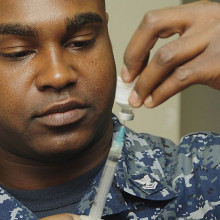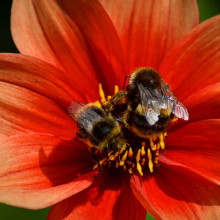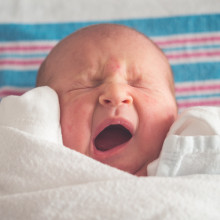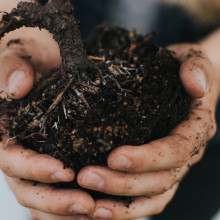In the news this week, Elon Musk's Starship experiences a 'rapid unscheduled disassembly', there's progress in developing a universal flu vaccine, and the sounds which might help your little one to fall asleep...
In this episode

01:08 - SpaceX Starship blows up after launch
SpaceX Starship blows up after launch
Richard Hollingham
SpaceX's Starship - the most powerful space rocket ever built - has blown up shortly after its launch in Texas. SpaceX is owned by one of the world’s richest men, Elon Musk, and he has said that his team would try again in the coming months. But does the latest setback leave his space ambitions in tatters? With the analysis is the science journalist, author and BBC presenter, Richard Hollingham.
Richard - It blew up. But before that, it was, I would say, a successful launch. So this enormous rocket, 120 metres tall, all 33 engines fired. It dragged itself off the launch pad and all seemed to be going well until about three minutes into the mission. And this is a massive rocket, at which point, the two parts of it, the upper stage, which has these little wings on the top, looks like a proper, proper starship, failed to separate from the lower stage. And then around four minutes into the flight, it blew up. Now it probably blew up automatically with an automatic system or engineers triggered it to blow up because by that time, the mission was, was failing. Also, by that time, partway into the mission, not all 33 engines were firing. So 27 of the 33 were firing. But nevertheless, it's an extraordinary engineering achievement to get something like this off the ground at all. And they absolutely considered it a success. And I love the engineering speak phrase they used for the explosion. They called it rapid, unscheduled disassembly.
Chris - <laugh>. It's like when someone falls from a great height and says they suffered deceleration injury. But no one was hurt in this, were they? I mean, this was unmanned.
Richard - No one was hurt. No people on board. I mean, that was one of the great achievements because I mean they'd not been building this up. Elon had been very much managing expectations in his tweets over the last few weeks about this launch. It'd already been postponed. It looked like it was almost going to be postponed again. One of the big fears was it would blow up on the launchpad and then you are back, years probably, to just have to rebuild the launch pad and that whole ground infrastructure around it. But the fact that it got off the ground, it reached 39 kilometres above the Earth, there was a round of applause in mission control. So they're very much considering this a success and the next step will be another attempted launch of another Starship. They’ve got several waiting in a few months time once they've figured out exactly what went wrong.
Chris - And just briefly, Richard, why do they need this rocket? What's it going to do? What's the ambition for it?
Richard - Well, the initial ambition is to make money. So, Elon Musk wants to launch an awful lot of satellites. It can launch 150 tonnes worth of satellites into orbit. More long term, he wants to carry people, and this can carry up to a hundred people. NASA has contracted SpaceX to use Starship to land its astronauts on the moon as part of its Artemis program. So it's needed in the next few years, at least. The upper stage is needed for that. And ultimately, Elon Musk wants to set up settlements on Mars. So starships are destined to carry people to Mars ultimately.

04:53 - Universal flu vaccine breakthrough
Universal flu vaccine breakthrough
Karin Bok, NIH
Are we a step closer to a universal flu vaccine that blocks any flu infection and lasts several years? That's the hope. Scientists in America have homed in on certain parts of the outer coat of the influenza virus that are the same in many different forms of flu. And because those regions can't change, because doing so would affect the ability of the virus to infect and grow, the vaccine can provide longer term protection. This week they published the results of their first clinical trial of the approach in humans. Karin Bok is the Deputy Director at the NIH Vaccine Research Center...
Karin - Influenza virus is very, very smart. And I would say even much smarter than coronaviruses. They have many, many tools at their disposal to evolve, to change, to avoid being targeted by our immune system.
Chris - The virus is essentially sidestepping immunity by looking different.
Karin - Yes.
Chris - So even though we've been vaccinated, or even caught flu previously, that doesn't endow us with defence against a virus that now looks different.
Karin - Exactly. It's almost as if you were getting in touch with a new virus, a new influenza, every year. So what we have to do is study very carefully the virus at the microscopic level and try to find pieces of that virus that do not change. There are some pieces of the virus that are either more hidden from our immune system or the virus is not able to change that part because it would mean catastrophic consequences for their growth.
Chris - If those components of the virus that don't change, these so-called conserved areas, are in all these flu viruses, and they're already there, why don't we make our own immune response when we catch flu against those so that we are immune to all future flus?
Karin - Another great question, and the answer to that is because the virus is very smart and the most exposed parts of the virus, the parts that our immune system sees first, are the ones that we are most likely to react to and are the ones that the virus changes every year.
Chris - I suppose then there are two issues here: one is you've got to find a way to make the immune system respond to these bits of the virus that it wouldn't normally respond to because the virus hides them, so you've got to disclose them in some way. And then you've got to prove that once you've got that immune response to those bits, that it is a protective immune response.
Karin - Exactly. Yeah.
Chris - And how have you achieved each of those aims? Let's start with how you have made the immune system see what was formally invisible on the virus, parts that it kept hidden so we wouldn't react to it?
Karin - So this is a very cool process and it is the same process we used to make the SARS CoV 2 vaccine. We call them designer vaccines, because it's the first time we've gone to the smallest part of a virus. We say, "we don't like the way the virus has built this part of their outside. We're going to try to rebuild it ourselves in the lab, and we're going to try to use that as a vaccine." So we're not only saying we're going to target parts of the virus, we're also redesigning the virus because, if we redesign it, the immune system will respond better. And by redesigning we mean stabilising. We really cut parts of the virus that we don't want to be there, and we redesign it to be a stable vaccine. So the immune system sees it and has an immune response.
Chris - What's in the tin? What's going on? Do you take the gene that corresponds, or the piece of genetic information that corresponds to the thing you want and make cells make that which you then purify with your modifications intact? And that's what you are giving the patient in order to see if the immune system will respond?
Karin - So in order to build a new building, you need to know how to build buildings. First we have to study the virus itself to see how it's built. And then, as you said, we take that gene for that part of the virus and we modify the gene before putting it into the cells. And we grow it and then we purify it and we use it as part of our vaccine.
Chris - And then how do you address part two, which was proving that when you expose a person or an animal or whatever to that modified protein that you've made, it is protective and it it is protective in the long term, which is your goal against lots of different types of flu.
Karin - This study that we just published is the first attempt to vaccinate humans. And, as you know, the first time you vaccinate a human it's just to establish the safety of the vaccine. So we haven't been able to test that in humans, but in animals and in the lab, in cells, we know that it blocks the virus. So there is proof that this part of the virus in a vaccine is able to generate the kind of immune response that we want in a vaccine.
Chris - And does that include not just longevity of the response, which was one of your goals, but also if I come along with a completely different kind of flu and expose a vaccinated individual to that, they would be protected?
Karin - Yeah. And what we've been able to understand is that you have, or the animal that's immunised with this vaccine has an immune response to other types of flu that are not present in the vaccine. And that is a breakthrough which is why we're excited.

10:48 - Earth Day 2023's Nature Overheard project
Earth Day 2023's Nature Overheard project
Abigail Lowe, Natural History Museum
People around the world are holding events to mark Earth Day 2023, as efforts continue to force the hand of decision-makers to tackle climate change. The Natural History Museum in London wants the public to join them in a major new community science project called ‘Nature Overheard’ - which aims to investigate the link between noise pollution and insect populations. With that in mind we set our colleague, Will Tingle, loose on the streets of north-west Cambridge. But first, the Natural History Museum’s Dr Abigail Lowe to explain a bit of the background…
Abigail - Nature Overheard is the Natural History Museum's latest community science project where we're asking as many people as possible to join an effort to better understand the impact of noise pollution on wildlife near roads. And so anyone can get involved by recording sound and sightings of insects near roads and streets. And we can use this information to make streets more wildlife friendly. And we launch on Earth Day April 22nd. So it's a perfect opportunity to link the two things together, do some community science, do your bit, connect to your local nature, and yeah, become a scientist. We are hoping to look at how the levels of noise pollution are affecting insect abundances and distributions, but not only that, we can work to identify insect sounds from the audio recordings. So there's been a lot of work already on training algorithms to identify bird species from audio, but we're developing the technology now to be able to do the same for insects. So it's a really exciting project for people to get involved in.
Will - Well, it sounds like we shall have to have a go...
Will - <Car driving past> Well then, James, it's time to do some more citizen science for the people.
James - My favorite.
Will - We've got a stringent checklist to go through here. Before we get started, would you mind checking for me that it's between 10am and 4pm?
James - Affirmative.
Will - Good. Are we near a road?
James - Yep.
Will - Good. Is it warmer than 13 degrees? I'll spoil it for you now. It is warmer than 13 degrees. And is it only a light wind?
James - Yeah. Verging on gusty.
Will - We'll do our best. What's left to do now then is to walk along this road, take some audio recordings for our friends at the Natural History Museum and if we spot the insects, try and call 'em out. Photograph them and ID them.
James - Let's go.
James - Oh?
Will - Oh no, you're right. You're right.
James - <laugh> They're not easy to identify when they're moving around so quickly.
Will - That's alright. You've got me James. We've got ourselves a solitary bee, a brimstone butterfly, two hoverflies. We're off to a flying start. We've got a lot of gnats flying around. More butterflies, James. What are you? Oh, that's a peacock butterfly. Delightful.
Will - Oh, now this is curious James. Look at this. It looks like a bee, but it's actually a fly. Guess what it's called?
James - <Laugh>. I don’t know. It's got a long nose though.
Will - Well, don't say nose, James. But it has a long proboscis, but it's a bee fly. It's interesting. It's a fly pretending to be a bee so that nothing will eat it.
James - How are the non-zoologically trained among us supposed to identify all these creatures? You'll be pleased to know that the Natural History Museum has handily given everyone a nice insect invertebrate guide for them to follow on the website if they want to take part in this.
James - Why are we looking for bugs and insects in particular? Why not other aspects of wildlife?
Will - Excellent question, James…
Abigail - Insects are really important for maintaining a healthy environment. They have many roles. They're predators. They're parasites. They pollinate flowers, which gives us food and crops and things like that. So insects are really important, but we don't know a lot of things about them. So we need to research more into them. And one of the things that is under researched is the impact of what noise pollution has on them. The community science program Nature Overheard is unique because it was co-designed by students across the UK. So we gathered hundreds of questions from across the UK and we narrowed them down to the question which was, 'how can we make roads better for nature?' And we ran a series of workshops to sort of refine and develop that question a little bit further. And that is how we ended up on the idea of investigating road noise pollution. And we were very lucky at the museum to have Ed Baker, who's an acoustic biology researcher. So he looks at sound recordings and tries to identify wildlife from them. So it sort of all just worked out really well. Really it was amazing that the students had identified this problem as something that they were really interested in.
Will - What are you planning to do with all of this data once you've collected it and identified what's going on in it?
Abigail - Nature over here is going to run for two years. For the first year, we're very much gonna be looking at some basic acoustic indices relating to what people are seeing on the roads. And then the technology for identifying things like birds from acoustic data is fairly well developed, but being able to identify insects from it is not quite there. And so we need to gather lots of audio recordings so that we can start to train the algorithms. The information that we collect, we'll use it to share with road developers and councils and local communities about how we can try and make the sides of roads better.
Will - Well, James, I would like to put that down as a pretty good success.
James - Yeah, it was a lovely way to spend an hour.
Will - Absolutely. And I think that hopefully the data we've collected here could be added to the mosaic that the Natural History Museum is putting together in tracking the distribution of insects near our roads.

17:25 - Soundscapes to soothe infants
Soundscapes to soothe infants
Lyz Cooper, British Academy of Sound Therapy
You might think the children’s classics “Twinkle Twinkle Little Star”, and “Puff The Magic Dragon” might be the best lullabies to help soothe a little one to sleep. But might there be a superior sound? The founder of the British Academy of Sound Therapy, Lyz Cooper, has produced a new research-based lullaby in collaboration with a top music producer and she reckons it sounds a bit like the Floyd. She’s been speaking to our man, Will Tingle...
Lyz - I collaborated with a really good producer called Silky. We worked over Zoom on the piece and, at one point, I saw him looking down while we were playing the piece back and I thought, "he's texting, he's on his phone and he's texting, not paying attention." An at the end of the piece he looked up and he said, "oh, I'm sorry, I just dozed off for a minute there."
Will - Well, I was actually going to mention that my sister had a kid fairly recently. He's coming up to sort nine months and he is in that window where they won't sleep. So I'm going to forward it to them and I'll give you some feedback.
Lyz - Definitely. Yeah, absolutely. We'd love to hear from anybody that uses it.
Will - Brilliant. On the subject of sound therapy, to take a step backwards from this individual project, when you do sound therapy, what elements work best? Or does that depend on what you're hoping to achieve?
Lyz - It really does depend on the intended therapeutic outcome. Now, of course, there's never any guarantee, but we've done quite a lot of research at the British Academy of Sound Therapy over the last 20 years. And we've developed formulae that are based on the way that the brain is wired to respond to sound. So what we're mainly aiming for in what we might call a passive session, which is where a client comes in, we obviously take a full case history and we ask them what it is they'd like to work on, they lay down on a treatment table, so like a massage couch, and we make them all lovely and comfortable. And then we begin to play and we'll play continuously for around 30 to 40 minutes
Lyz - And the sonic prescription that we put together will be designed to help people to go into a deep, altered state of consciousness. So that's a very, very deep relaxed state, almost like that lovely, fuzzy place just when you're about to wake up or when you are about to go to sleep. People are still conscious, but drifting in that place. And our research has shown that there's lots of lovely positive benefits to health and wellbeing when we're in that place for a sustained period of time.
Will - There's a lot going on in it. It's a very multi-layered piece of audio. How did you decide what to put in that track?
Lyz - Well, that's a really good question. First of all, obviously we have our brief. So the idea is we know that we need to do our best to induce sleep. But we're also appealing to a particular audience, in this case, babies. If they're very newborn, then they'll be used to the sort of safety sounds like the womb sounds. Now even big babies, because, at the end of the day, we are all big babies, we have that memory of being in the womb. And so that's one of the reasons why we find those lovely watery sounds, the white noise-y sounds of waterfalls, ocean sounds, really relaxing. So, with this particular piece, the design that I created was to start off by allowing that feeling of safety to happen. We took out a lot of the high frequencies because low frequencies relax. A lot of the work that I do involves lots of layering up of textures. Beautiful drifting soundscape sounds.

22:21 - Bone density in space linked to microbiome
Bone density in space linked to microbiome
Joe Bedree, UCLA
One downside of being one of the few lucky scientists sent to space is that, when you return to earth, you might be left with the skeleton of a 70 year old. The natural remodelling our bones go through gets disrupted when our bodies are exposed to microgravity, and you can lose 1-2% density for every month you’re up there. Why this happens, scientists are not entirely sure, but they think it has something to do with changes in our microbiome - the trillions of bacteria living inside us. To help get to the bottom of things, UCLA’s Joe Bedree studied the simultaneous changes to the microbiome and bone density of mice sent up to the International Space Station. He hopes that his research, as well as helping astronauts, might also help the millions around the world suffering with bone conditions like osteoporosis.
Joe - What's really cool is NASA has this device called the rodent habitat. It almost looks like a giant computer case where the mice can kind of live and has sophisticated sensors and other kinds of cameras and things along those lines. However, since you're in microgravity, the fecal matter that we analyzed wasn't able to be actively sampled. And so at the end of the experiment, we had to acquire those samples and then did a kind of time point analysis there.
James - And can you sum up, well, your findings, the change in the microbiomes of these mice that you'd sent into space?
Joe - The microbiomes were relatively similar between flight and ground, except for a handful of species. And two species in particular, Lactobacillus and Dorea were elevated in the flight group, which was really interesting. We see these changes in microbes. We see their ability to potentially contribute to some of these metabolites that we detected. And then we saw that the bone homeostasis was changing. And so we thought perhaps this is just the host responding to microgravity and bone loss, or perhaps it could be an active compensation. But further studies are needed to really validate those hypotheses.
James - And you've kind of preempted my question there, Joe, about how you separated cause and affect here. Whether it was the changes in the microbiome that affected the body of the mice, or whether it was the changes in the bone density of the mice that changed the microbiome.
Joe - As much as I do love microbiology and the microbiome, I think my kind of scientific hunch, although I don't have evidence to prove this right now, is that it's probably the body that's influencing the microbiome and it could be a response. So one other piece of information that I think is really important is that mice participate in this behavioral called coprophagy, in which they ingest their own feces, which in microgravity they're not able to do.
James - Lovely.
Joe - I know it's quite an interesting process, but it's another way where they can kind of reintroduce microorganisms from the environment. And so while that is an aberration from normal behavior, it also offered a really unique opportunity, a kind of almost a selection event, in this unique environmental exposure. So again, we'll need to see if we can evaluate whether these microorganisms could actually mitigate bone loss.
James - Just so I have understood, correct me if I've got this wrong, you saw the microbiome increase in diversity of the mice you sent into space, and usually you'd associate that with health benefits, if anything. But is it kind of unique that you've seen actually have a detriment to health in this case?
Joe - Yeah, you're asking all of the great questions and I think this is a really great moment to kind of take a step back because this is a unique environment and you really literally have gravitational forces that are affecting all of these different cellular processes. Given that context, you know, really at the end of the day, this is just a selection pressure on the microbes. And so whether the diversity increases in this case doesn't necessarily mean that it's going to kind of confer a particular health benefit or health loss, but the microbes are responding to this environment and then there's a multitude of different biological processes that are changing.

27:25 - Farmland contributes 4% of carbon emissions
Farmland contributes 4% of carbon emissions
Tom Marquand, University of Cambridge
When we talk about fighting climate change, you most often hear about efforts to reduce the quantity of fossil fuels we burn. What you don’t hear about so often is the contribution of farmland to greenhouse gas emissions. Nowhere is this subject more relevant, perhaps, than right on our doorstep here in Cambridgeshire. Closeby are the Fens - nearly 4000 square kilometres of marshy, fertile soil. Until the 1600s, this region was a low-lying swamp, and it wasn’t until Dutch engineers were brought in to drain it that it was turned into productive farmland. The soil that emerged as a result was carbon rich, causing microbes in the earth to belch out vastly more co2 and methane than normal soil. This has negative impacts on farming yields as well as the planet, and here to tell us more is Tom Marquand, who’s been conducting a research project into the Fens at the University of Cambridge…
Tom - In general, we have a pretty good understanding of the very basic principle that when you remove water from the soil, you allow air to get deeper into the soil. And that brings with it a lot of oxygen. That's what the microbes need to break down that soil carbon and release a lot of co2. And that's what they're doing right now. That basic picture is well established, what we don't have such a good handle on is the nuances. How does the temperature affect it? How does it vary seasonally? Specifically, if I raise the water table by 10 centimetres, what is the number? How much less co2 is emitted? Those are really important things to have a strong grasp on if you want to make informed policy decisions in the future.
Chris - So you've effectively got the makings of a model of how this sort of environment works and, when we change it or do something to it, what the anticipated outcome would be?
Tom - That's the dream. Yeah. My collaborators and I are not the decision makers, but what we really hope to be able to do is to produce a body of evidence that's really well grounded in cutting edge research that allows the policy makers in the future to make really informed decisions about what the future of the Fens looks like.
Chris - It's an important area, it's a a big area, but it's just one area. The planet's much bigger. Can this be extrapolated from what's going on in the Fens to other environments like it elsewhere? Does it inform the bigger picture?
Tom - Definitely, definitely. I think the Fens are a really great place to start with this bigger picture of soil carbon emissions globally. Human land use accounts for about 4% of our greenhouse gas emissions. So it's a huge contributor overall. And if this is something that we can get more of a handle on, then that would be really useful in the future, all over the world.
Chris - How much emission is coming off the Fens? I've said that it's a lot, but put some numbers on it.
Tom - Yeah. So the East Anglian Fens on their own account for 400,000 tons of carbon being emitted each year and that's being emitted almost entirely as co2. There's very little methane emissions from the Fens and that's something that you see more in a natural wetland than in a drained one.
Chris - And so what would be the ultimate goal then? Is it to work out whether we should re flood some parts of the Fens? Would that mitigate things? Because obviously there's a price to pay in food production if we do remove some of it to cut down some of that carbon footprint. Do we end up reimporting food from elsewhere with an attached carbon footprint, which may have knocked down a rainforest somewhere to grow?
Tom - Definitely. I mean this is the really tricky thing. To some degree, I'm very happy that I am the person putting together the evidence and not the person making the decision. The decisions that will have to be made about the future of the Fens will be really difficult. Ones that have to balance this economic and food security side with an environmental and sustainability side. At the moment, the Fens are losing peat, so we actually can't carry on as we are, even if we really want to. We're going to have to do something, and that's why this matters. It's a massive contributor to our food supply. We don't really want to move that abroad. And I think what most of the people I'm working with and speaking to would really like to see is more sustainable farming practices and a sort of patchwork landscape where maybe some of it can be given over to wetlands and nature reserves for biodiversity and for trapping carbon, and some of it can be farmed in perhaps a more sustainable but still productive way. That's the goal, at least.
Related Content
- Previous Dealing with Diabesity
- Next Do we have two sets of DNA?










Comments
Add a comment